Jim Gleeson - Japanese Hiragana: An Introductory Japanese Language Workbook
Here you can read online Jim Gleeson - Japanese Hiragana: An Introductory Japanese Language Workbook full text of the book (entire story) in english for free. Download pdf and epub, get meaning, cover and reviews about this ebook. year: 2013, publisher: Tuttle Publishing, genre: Children. Description of the work, (preface) as well as reviews are available. Best literature library LitArk.com created for fans of good reading and offers a wide selection of genres:
Romance novel
Science fiction
Adventure
Detective
Science
History
Home and family
Prose
Art
Politics
Computer
Non-fiction
Religion
Business
Children
Humor
Choose a favorite category and find really read worthwhile books. Enjoy immersion in the world of imagination, feel the emotions of the characters or learn something new for yourself, make an fascinating discovery.
- Book:Japanese Hiragana: An Introductory Japanese Language Workbook
- Author:
- Publisher:Tuttle Publishing
- Genre:
- Year:2013
- Rating:3 / 5
- Favourites:Add to favourites
- Your mark:
Japanese Hiragana: An Introductory Japanese Language Workbook: summary, description and annotation
We offer to read an annotation, description, summary or preface (depends on what the author of the book "Japanese Hiragana: An Introductory Japanese Language Workbook" wrote himself). If you haven't found the necessary information about the book — write in the comments, we will try to find it.
Jim Gleeson: author's other books
Who wrote Japanese Hiragana: An Introductory Japanese Language Workbook? Find out the surname, the name of the author of the book and a list of all author's works by series.



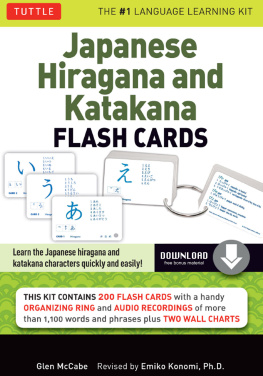


![Eriko Sato - My First Japanese Kanji Book: Learning kanji the fun and easy way! [Downloadable MP3 Audio Included]](/uploads/posts/book/406403/thumbs/eriko-sato-my-first-japanese-kanji-book-learning.jpg)


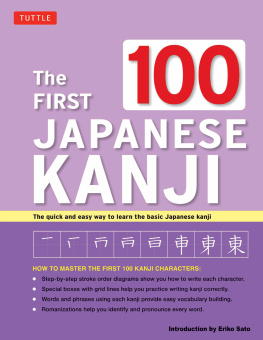





 In both printed and handwritten Japanese, the characters occupy imaginary squares of equal size, with each character centered within its square. All of the writing practice in this book involves writing characters within squares, and the squares have centerlines to provide the correct balance and feel for writing Japanese. Traditionally, Japanese is written with a brush or fude, and this fact is reflected in many typographic styles today. Although the fude is no longer widely used, some principles of using a fude still apply to writing Japanese with a pencil or biro in particular, the stroke endings. The strokes of Japanese characters terminate in one of three ways, as illustrated below. i) Jumping, to produce a hook at the end of the stroke.
In both printed and handwritten Japanese, the characters occupy imaginary squares of equal size, with each character centered within its square. All of the writing practice in this book involves writing characters within squares, and the squares have centerlines to provide the correct balance and feel for writing Japanese. Traditionally, Japanese is written with a brush or fude, and this fact is reflected in many typographic styles today. Although the fude is no longer widely used, some principles of using a fude still apply to writing Japanese with a pencil or biro in particular, the stroke endings. The strokes of Japanese characters terminate in one of three ways, as illustrated below. i) Jumping, to produce a hook at the end of the stroke.  When tracing over the characters, be sure to keep these three types of stroke endings in mind, observing how the strokes of the gray-tinted characters terminate.
When tracing over the characters, be sure to keep these three types of stroke endings in mind, observing how the strokes of the gray-tinted characters terminate. 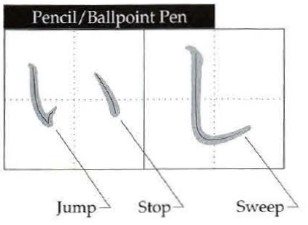 In Japanese, as in English, there are many differences between handwritten and typeset characters.
In Japanese, as in English, there are many differences between handwritten and typeset characters.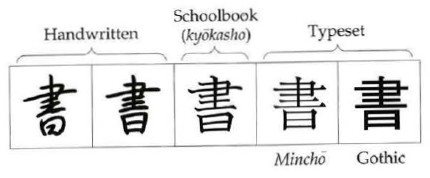 To provide familiarity with a range of type variations, each character entry in this book is accompanied by four different character styles, as shown below. These variations are included for recognition only.
To provide familiarity with a range of type variations, each character entry in this book is accompanied by four different character styles, as shown below. These variations are included for recognition only.  The upper left variation is a bold Minch typeface while the upper right variation is a bold Gothic typeface.
The upper left variation is a bold Minch typeface while the upper right variation is a bold Gothic typeface.
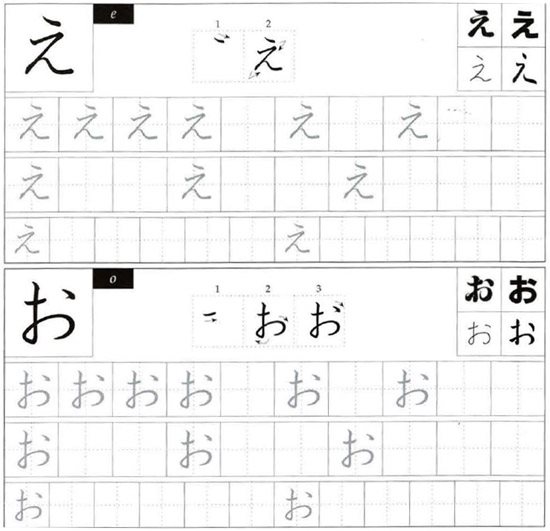 Practice to meet a friend
Practice to meet a friend 
 au - to meet to return home
au - to meet to return home 
 ie - house on the desk
ie - house on the desk 
 ue - above, up, on
ue - above, up, on
 Practice to write a letter
Practice to write a letter 
 kaku - to write, to draw to listen to music
kaku - to write, to draw to listen to music 
 kiku - to listen, to hear, to ask It is here.
kiku - to listen, to hear, to ask It is here. 
 koko - here
koko - here
 Practice to put up an umbrella
Practice to put up an umbrella 
 sasu - to indicate, to point (a finger), to put up (an umbrella) to eat sushi
sasu - to indicate, to point (a finger), to put up (an umbrella) to eat sushi 
 sushi - sushi, fish on vinegared rice to get up in the morning
sushi - sushi, fish on vinegared rice to get up in the morning 
 asa - morning
asa - morning I speak loudly.
I speak loudly. 

